Accepted Scientific Name: Adenium obesum subs. swazicum (Stapf) G.D.Rowley
Repert. Pl. Succ. (I.O.S.) Notes: A. swazicum
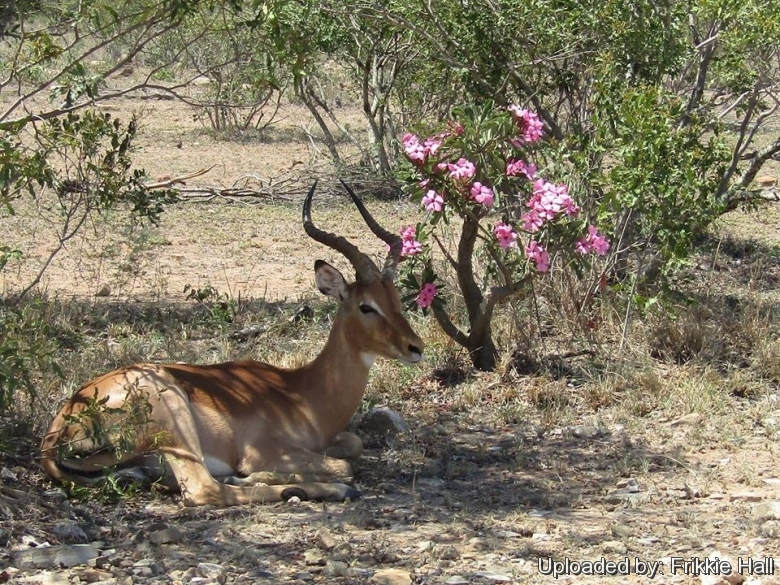
Adenium boehmianum var. swazicum (Adenium obesum subs. swazicum) Photo by: Frikkie Hall
Adenium swazicum colony in the Kruger National Park. The summer Impala Lily (Adenium Swazikum) together with its namesake, the Impala antelope (Aepyceros melampus).
Origin and Habitat: Adenium obesum subs. swazicumSN|109]]SN|109]] occurs on the east coast of southern Africa, in North Kwazulu-Natal, Swaziland and adjacent parts of South Africa. Also recorded from southern Mozambique (between Magude and Chobela).
Altitude range: 300–400 metres above sea level.
Habitat and ecology: This species grows in open lowveld woodland, usually on sand and often brackish soil.
Synonyms:
See all synonyms of Adenium obesum
Common Names include:
ENGLISH: Impala Lily
Description: Adenium obesumSN|110]]SN|116]] ssp. swazicum (Adenium swazicumSN|107]]SN|110]]), the Impala Lily, is a dwarf shrub, 20-70 cm high, with an enlarged succulent stem with few branches, sometimes partly below ground that tend to droop or spread, especially in plants that are too shaded; mature plants have massive roots and thick stems, but a caudex is evident only in young ones. Flowers are showy, pink or mauve to deep reddish purple, usually darker in the throat, appearing with the leaves.
Distinctive characteristics: This subspecies has leaves pubescent beneath, the corolla is glabrous and the anthers tail is shorter than tube. It is similar to Adenium obesum subs. boehmianumSN|110]]SN|107]], but differing in the much narrower glabrescent leaves and oblique, very indistinct lateral nerves.
Stems. With swollen carrot-like basal part (tuber) 10-15 cm in diameter (but at times up to 1 metres in diameter), most of which is below ground, bearing 1-several aerial branches. Branches erect, simple or sparingly branched, 15-30(-50) cm high and 1-1 -5 cm in diameter. Stem and branches with poisonous clear latex, glabrous with the exception of the youngest parts, whitish when dry.
Leaves: Leaves clustered at the ends of the branches, succulent, somewhat coriaceous, 7-13 cm long, 1-3 cm wide, almost sessile, oblanceolate to oblong-oblanceolate or obovate-cuneate (widest near the tips), acute to apiculate or rounded at the apex, rarely emarginate, gradually narrowed into the basal cuneate portion, often folded lengthwise along the midrib and usually slightly crisped (wavy), softly pubescent on both sides when young, ultimately losing hairs above and without conspicuous veins, secondary nerves oblique, indistinct or quite obscure, 3-7 mm apart. The leaves are lighter green than in most adeniums and slightly glaucous when fresh. The petiole is up to 3 mm long, with glands present in the axil. Stipules minute, early deciduous.
Inflorescences: Few-flowered cymes. Terminal or pseudo-axillary, appearing with leaves, greyish-tomentose. Bracts lanceolate, 4-5(-10) mm long. Pedicels 5-8(-15) mm long tinged with pink or red.
Flower: Uniformly coloured pink to deep reddish purple, varying considerably in size, appearing with the leaves, average 6-7 cm in diameter. Calyx 6-11 mm long crimson or pink to green. Sepals lanceolate, acuminate, pubescent to subtomentose. Corolla crimson, deep mauve or pink to white, purple in the throat. Tube crimson to white, 2.2–3.5(4) times as long as the calyx, 20–30 mm long, (6-)10–13(19) mm broad, outside pubescent, only at the very base nearly glabrous, glabrescent inside. Corolla lobes rounded to obovate, about 2,5 cm long, slightly undulate, both sides puberulous. Throat-scales obscure. Stamens included. Infra-staminal part of the tube 8 mm long, with 5 densely tomentose lines below the stamens, glabrous at the base, supra-staminal part about 2 mm long, wide-tubular, glabrous within. Anthers about 5-6.5 mm long, hairy on the back, apical tails 6-10 mm long, obtuse, densely villous. Pistil 9–11.5 mm long. Style 5.5–7(9.5) mm long.
Blooming season: This species blooms over a long season normally in late summer and autumn (Some clones, however, are in almost continuous bloom, experiencing only a few weeks of rest in late winter).
Fruits (follicles): Grey-brown, up to 16 cm long and 1 cm in diameter.
Seeds: Pale-brown, glabrous, 12–14 mm long, 3 mm broad. Comas (tuft of hair) dirty white, 28–35 mm long. The seed are released from the fruit when they split open. As the coma dries out on the tip of the seed it unfolds into a parachute-like structure that carries the seed off in the slightest breeze. After a time the coma detaches and if the seed lands in a suitable place it will germinate and establish a new plant.
Hybrids: Adenium swazicumSN|116]]SN|110]] was used in intergeneric hybrids with A. obesum and some of the most floriferous hybrids belong to this group.
Subspecies, varieties, forms and cultivars of plants belonging to the Adenium obesum group
 Adenium arabicum Balf.f.: is similar in appearance to Adenium obesum, but creates a massive, more squat and fat caudex and has larger thick fleshy leaves. Distribution: Yemen and Saudi Arabia.
Adenium arabicum Balf.f.: is similar in appearance to Adenium obesum, but creates a massive, more squat and fat caudex and has larger thick fleshy leaves. Distribution: Yemen and Saudi Arabia. Adenium dhofarense Rzepecky: Has large, leathery and glossy leaves and very small flowers. Distribution: Dhofar coast (Oman) and adjacent mountains of Yemen.
Adenium dhofarense Rzepecky: Has large, leathery and glossy leaves and very small flowers. Distribution: Dhofar coast (Oman) and adjacent mountains of Yemen.  Adenium obesum Roem. & Schult.: The trunk will get up to one meter in diameter, and the plant will grow op to five meters.
Adenium obesum Roem. & Schult.: The trunk will get up to one meter in diameter, and the plant will grow op to five meters.- Adenium obesum f. albiflorum Lodé
 Adenium obesum subs. boehmianum (Schinz) G.D.Rowley: The flowers are similar to those of A. swazicum but the leaves are broader pale grayish-green.
Adenium obesum subs. boehmianum (Schinz) G.D.Rowley: The flowers are similar to those of A. swazicum but the leaves are broader pale grayish-green. Adenium obesum subs. oleifolium (Stapf) G.D.Rowley: succulent shrublet 12-40 cm high from a subterranean rootstock. It has long, narrow leaves frequently folded along the midrib. Distribution: Botswana, Namibia and S. Africa.
Adenium obesum subs. oleifolium (Stapf) G.D.Rowley: succulent shrublet 12-40 cm high from a subterranean rootstock. It has long, narrow leaves frequently folded along the midrib. Distribution: Botswana, Namibia and S. Africa. Adenium obesum subs. socotranum (Vierh.) Lavranos: It is the giant of the genus, forming a massive conical trunk/caudex several metres tall and up to 2.4 m in diameter. It resembles a miniature baobab.
Adenium obesum subs. socotranum (Vierh.) Lavranos: It is the giant of the genus, forming a massive conical trunk/caudex several metres tall and up to 2.4 m in diameter. It resembles a miniature baobab. Adenium obesum subs. socotranum f. cristata hort.: crested form.
Adenium obesum subs. socotranum f. cristata hort.: crested form.- Adenium obesum subs. somalense (Balf.f.) G.D.Rowley
 Adenium obesum subs. swazicum (Stapf) G.D.Rowley: It is a dwarf shrub, up to 30 cm high, with an enlarged succulent stem with few branches. The caudex is evident only in young specimens.
Adenium obesum subs. swazicum (Stapf) G.D.Rowley: It is a dwarf shrub, up to 30 cm high, with an enlarged succulent stem with few branches. The caudex is evident only in young specimens. Adenium somalense var. crispum Chiov.: is a dwarf form of A. somalense (less than 30 cm tall) with white flowers heavily striped with red or completely red and a large underground napiform caudex. Distribution: Coast of southern Somalia.
Adenium somalense var. crispum Chiov.: is a dwarf form of A. somalense (less than 30 cm tall) with white flowers heavily striped with red or completely red and a large underground napiform caudex. Distribution: Coast of southern Somalia.
Bibliography: Major references and further lectures
1) Otto Stapf “Flora Capensis”, Vol 4, 1909
2) Werner Rauh “The Wonderful World of Succulents: Cultivation and Description of Selected Succulent Plants Other Than Cacti” Smithsonian Institution Press, 1984
3) Urs Eggli “Illustrated Handbook of Succulent Plants: Dicotyledons” Springer Science & Business Media, 2002
4) J.P. Roux “Flora of South Africa” 2003
5) A. J. M. Leeuwenberg and F. K. Kupicha et al. “Flora Zambesiaca” FZ, Vol 7, Part 2, 1985
 Adenium swazicum (during winter rest) (Adenium obesum subs. swazicum) Photo by: Valentino Vallicelli
Adenium swazicum (during winter rest) (Adenium obesum subs. swazicum) Photo by: Valentino Vallicelli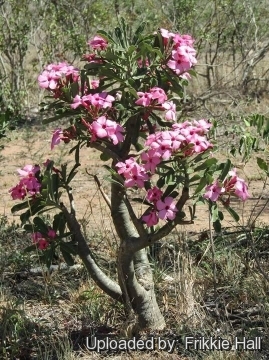 Adenium boehmianum var. swazicum (Adenium obesum subs. swazicum) Photo by: Frikkie Hall
Adenium boehmianum var. swazicum (Adenium obesum subs. swazicum) Photo by: Frikkie Hall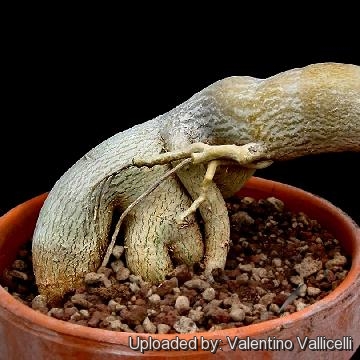 Well-developed plants have huge roots and thick trunks. (Adenium obesum subs. swazicum) Photo by: Valentino Vallicelli
Well-developed plants have huge roots and thick trunks. (Adenium obesum subs. swazicum) Photo by: Valentino Vallicelli Adenium boehmianum var. swazicum (Adenium obesum subs. swazicum) Photo by: Xero Sicyos
Adenium boehmianum var. swazicum (Adenium obesum subs. swazicum) Photo by: Xero Sicyos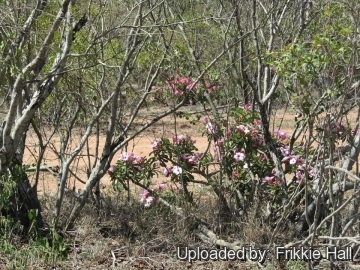 Light pink in front with darker pink one in the back. (Adenium obesum subs. swazicum) Photo by: Frikkie Hall
Light pink in front with darker pink one in the back. (Adenium obesum subs. swazicum) Photo by: Frikkie Hall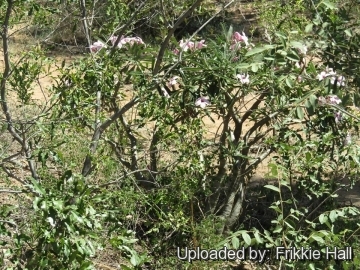 Bloming habit at Kruger National Park. (Adenium obesum subs. swazicum) Photo by: Frikkie Hall
Bloming habit at Kruger National Park. (Adenium obesum subs. swazicum) Photo by: Frikkie Hall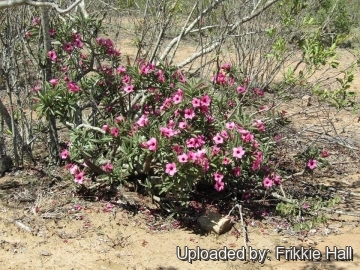 Bloming habit at Kruger National Park. (Adenium obesum subs. swazicum) Photo by: Frikkie Hall
Bloming habit at Kruger National Park. (Adenium obesum subs. swazicum) Photo by: Frikkie HallSend a photo of this plant.The gallery now contains thousands of pictures, however it is possible to do even more. We are, of course, seeking photos of species not yet shown in the gallery but not only that, we are also looking for better pictures than those already present.
Read More... Cultivation and Propagation: A.swazicum is easy to grow but is especially susceptible to spider mite infestation. It is nearly evergreen if grown in a warm greenhouse or tropical conditions a and watered, but can loose its leaves and forced into a long winter dormancy in cooler climate. New growth begins early in spring.
It like pots with generous drain holes on sides and bottom, need a very porous potting medium media (add pumice, vulcanite, and perlite) seeing that the main trunk is planted with the majority of the roots below the caudex line. Its rare that adeniums will use the upper third of their soil and often this area serves like a mulch or support for the stem.
To make plants develop a large swollen base/trunk and to increase flowering, they require a fertilizer rich in potassium and phosphorus without a too high nitrogen content.
Bright filtered light is best but in areas where light is not as burning, plants may be kept outdoors in full sun unprotected but remember that caudex is very susceptible to sun scalding.
Water plants preferably in the early mornings until the soil is well wetted and let excess water drains from the pot base. Watering can be done as they become drier even daily or to every few days during active growth season Never allow plants to dry out too often as this causes them to go into early dormancy. Many plants simply never get enough water to grow and flower adequately so keep them active and growing by providing them with all the essential necessities.
Propagation: Seed, grafting or cuttings that develop the same characteristics in a few years.

















